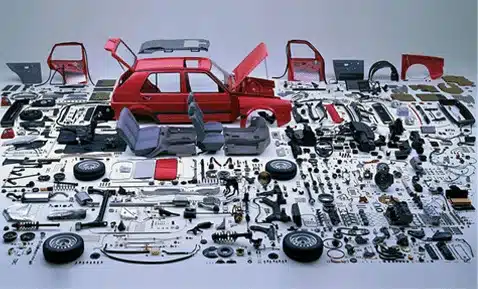The world is evolving towards a cleaner and more sustainable environment where every ecosystem is valued and treated with respect. This global movement has brought the concept of recycling to the forefront. In the context of the automobile industry, the need for a collective effort is apparent.
According to Wikipedia, 12-15 million vehicles reach the end of their useful life each year in the United States alone. This is just over half of the total number of cars that come to the end of their useful life annually, which stands at roughly 27 million vehicles globally.
A positive point to note is that out of these millions of cars discarded annually, a vast and growing percentage is recycled, too, with vital parts and components taken apart, reworked, and put into use.
The Environmental Impact of Traditional Car Part Disposal
Making new car parts requires significant resources, ranging from voracious energy needs to heavy demands for raw materials like steel and iron for car bodywork and engine parts to rubber, plastic, and wood.
Quite a number of resources go into manufacturing cars, which takes a toll on the environment when these resources are extracted and meshed together to fashion cars and other vehicles.
As their valuable years draw to an end, these cars, numbering in millions, are discarded, collected, and, in most cases, dumped at landfills, creating a significant environmental problem.
The standard method of disposing of cars is usually in landfills, which has significant environmental impacts. Landfills produce leachate and gases, including methane and carbon dioxide, which are important greenhouse gases.
Methane emissions from landfills contribute to global emissions and can adversely affect the environment and human health. Landfills also pose risks to public health through surface or groundwater contamination by leachate and the diffusion of litter into the wider environment.
In addition, landfills can result in inadequate on-site recycling activities and contribute to the emission of greenhouse gases, leading to extreme weather conditions and uncertain climate patterns.
Therefore, the disposal of cars in landfills can harm the environment, including air and water pollution, greenhouse gas emissions, and potential health hazards, creating a complex web of environmental issues.
Improper disposal of car fluids also poses a significant threat to the environment. These fluids, which include engine oil, coolant, brake fluid, and gasoline, contain toxic chemicals that can contaminate soil and water sources.
When dumped on the ground, they can seep into the earth, polluting groundwater and harming underground organisms. If they reach storm drains, they can be carried into rivers, lakes, and streams, poisoning aquatic life and disrupting ecosystems.
These pollutants can also pose health risks to humans who come into contact with contaminated water or consume fish from polluted waterways.
The Benefits of Recycling Used Car Parts and Fluids
The idea of recycling car parts and fluids has been touted over the years, but more attention needs to be paid to the benefits associated with this idea. We should know about the benefits of recycling to understand the essence and importance of gearing efforts to preserve and take care of our environment.
1. Protecting Our Planet
Car recycling is critical in preserving natural resources. Many car components, particularly steel and aluminium, are derived from mined materials. Extracting these resources can be environmentally destructive and require significant energy.
Recycling these metals from cars reduces the need for virgin materials, lessening the impact on our planet. Furthermore, reprocessing these metals requires substantially less power than virgin material production.
This translates to a significant reduction in greenhouse gas emissions and overall environmental burden. By recycling a car, you’re not just decluttering your driveway but contributing to a more sustainable future.
2. Fighting Pollution One Car at a Time
The significance of recycling must be considered. Car recycling offers a significant shield against pollution. When we dismantle and reuse car components, we conserve natural resources and avoid the environmental impact of extracting virgin materials.
It is much better for the environment if we don’t let the cars rot in a junkyard. Doing this reduces air and water pollution caused by mining and manufacturing processes. Furthermore, proper car recycling ensures the safe disposal of hazardous fluids and materials like lead and mercury, preventing them from contaminating soil and water sources.
Recycling steel alone from cars saves vast energy compared to producing new steel, lowering our carbon footprint. In essence, car recycling disrupts the cycle of pollution by giving valuable materials a new life and minimising environmental harm.
3. Supporting Salvaging Heroes
Car recycling is a crucial lifeline for salvaging companies. By responsibly disposing of old vehicles, car owners provide a steady stream of materials for these businesses.
Salvagers can then extract and refurbish usable parts like engines, transmissions, and body panels. These parts are sold at a fraction of the cost of new components, keeping repair costs down for consumers.
This cycle benefits car owners and salvaging companies and contributes to a more sustainable environment by reducing reliance on raw materials and preventing hazardous car fluids from polluting landfills.
4. Cutting Down Energy Consumption in the Automotive Industry
Car recycling significantly reduces energy consumption in the automotive industry. Extracting and processing virgin materials, like steel and aluminium, for new vehicles require immense energy.
Recycling these metals from old cars significantly lowers the energy demand. This is because recycling uses much less energy to re-shape and purify existing materials than creating them from scratch.
Car recycling substantially reduces overall energy use by minimising the need for virgin materials, leading to a more sustainable automotive industry.
5. Innovating with Recycled Materials
Recycled materials are not just about giving old items a second life; they’re a treasure trove for innovative product design.
Creatively repurposing plastic bottles, glass, or even discarded clothing, designers are crafting everything from high-performance sportswear to architectural elements.
This reduces reliance on virgin resources and fosters a circular economy, where waste becomes the raw material for something new and valuable. This focus on recycled materials pushes the boundaries of design and innovation, resulting in sustainable products that are both functional and exciting.
6. Safeguarding the Environment with Proper Fluid Disposal
Used car fluids contain harmful toxins and heavy metals, such as engine oil, coolant, and brake fluid. Improper disposal down the drain or onto the ground can lead to significant environmental damage.
When these fluids seep into the soil, they can contaminate groundwater and harm surrounding ecosystems.
Recycling facilities are equipped to handle these materials safely, preventing pollution and protecting our vital natural resources.
7. Conserving Resources and Energy Through Fluid Recycling
Many used car fluids can be re-refined into new lubricants or other usable products. Recycling these fluids reduces the demand for extracting virgin resources, such as crude oil for engine oil.
Furthermore, re-refining requires significantly less energy than producing new fluids from scratch. This translates to lower greenhouse gas emissions and a more sustainable approach to car maintenance.
We all share planet Earth as our home, and it’s our duty to appreciate and conserve its natural beauty. It’s essential to mitigate the harmful effects of our activities on the environment.
The first step in environmental protection is understanding the importance and benefits of recycling various items, especially cars and used car fluids. Next, we must spread this knowledge within our communities to restore and preserve our environment’s beauty and health.
Join us as we advocate for a greener environment.


